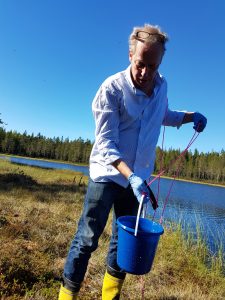AquaBiota can now present a revolutionising, and reliable, method to identify all fish species that occurs in a lake, through analysing DNA from a water sample! This is the first time this is achieved in Sweden.

More than 50 Swedish lakes and streams have been investigated and the results compared with earlier exploratory fisheries. The results from the comparisons shows that the new method is considerably more reliable, as it identifies all species accurately, also the rare and elusive species that are not always caught with conventional fishing methods. After the development of the method, AquaBiota has used the method for inventories in Östergötland, Dalarna and Norrbotten.
The method involves analysing the DNA that fishes and other animals excrete to their surroundings, and this DNA is called eDNA (environmental DNA). A considerable amount of international research has been devoted to the method, which is now reliable and efficient. The method to analyse several species within one group of organisms simultaneously is called Next Generation Sequencing (NGS). Also in Sweden eDNA from water samples have been used, but previously species have only been analysed one at a time. AquaBiota is first in Sweden to be able to use NGS for aquatic animals. The development of the current method has been performed in collaboration with the University of Hull (Great Britain) and MoRe Research (Örnsköldsvik).
The new method revolutionises fish sampling and, among other things, entail the following:
- Many more waters can be investigated as the field work to collect water samples is considerably faster than exploratory fishing methods. The sampling can also be performed from a helicopter.
- All fish species are detected with the eDNA-method, which means that the total biodiversity of fish can be investigated and monitored. All other fishing methods are selective, i.e. they target certain fish species or size classes.
- Also rare and threatened species can be monitored, without impact to the targeted fish. The method also does not have any impact on the benthic environment.
- The reliability is high, which results in considerably more reliable time series, and better possibilities to discover changes.
- The method works in all types of water: lakes, streams and also waters that are difficult to fish, such as large ocean depths or water under ice.
The method demands expertise within genetics, molecular biology and ecology to succeed.
- All of Sweden’s 100 000 lakes in a year, says Martin Isaeus, CEO of AquaBiota.
- We can thank CSI, that has inspired us to this research breakthrough, says Micaela Hellström, one of the researchers behind the method.
Read more about our work connected to eDNA.